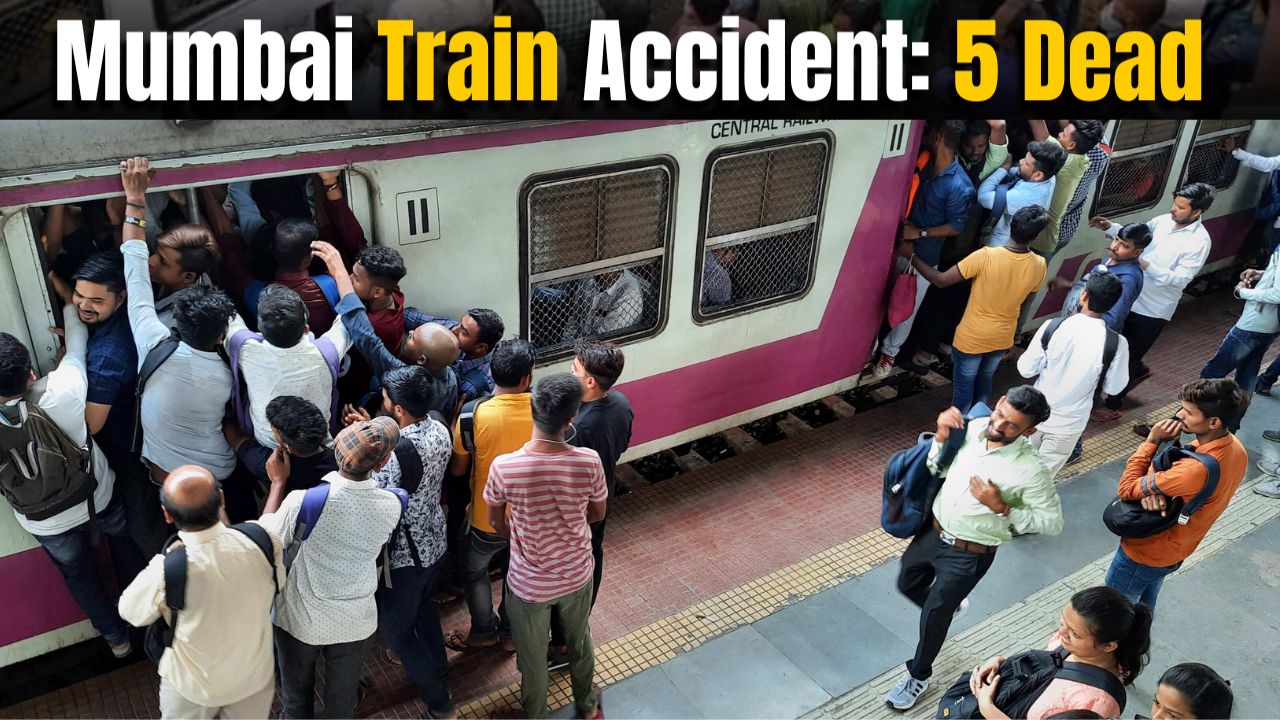
In a deeply tragic train accident on Monday morning, at least five commuters lost their lives and several others were injured after falling from a moving local train between Diva and Mumbra stations on Mumbai’s Central Railway line. The incident occurred during the peak rush hour, around 9:30 AM, when the train was heading towards Chhatrapati Shivaji Maharaj Terminus (CSMT).
According to initial reports, a group of 10 to 12 passengers fell from the train while it was crossing another local in the opposite direction. Many of the victims were reportedly hanging onto the footboards of the train due to overcrowding — a long-standing issue on Mumbai’s suburban railway network.
What Happened in the Train Accident?
Central Railway authorities confirmed that the incident took place when a fast local from Kasara to CSMT passed through a particularly congested stretch between D
The proximity of the two trains, combined with passengers hanging precariously from the doors, led to several of them losing balance and falling off onto the tracks. Tragically, five were declared dead on arrival at Kalwa Hospital, while others sustained serious injuries and were rushed to Shivaji Hospital and Thane Civil Hospital for treatment.
Victims and Eyewitness Accounts
The deceased were believed to be between 30 and 35 years of age, and the process of identification is currently underway. Eyewitnesses described scenes of chaos and horror, with people screaming for help and fellow passengers pulling the emergency chain in desperation.
One commuter, who survived the incident, recounted the moment the accident occurred:
“There was a sudden jerk and I saw people fall. It happened so fast. One moment, we were packed like sardines, and the next, a few were gone. The sound, the panic—it was terrifying.”
Train Accident Due to Overcrowding: A Chronic Issue
The train accident has reignited the debate around passenger safety in Mumbai’s suburban train system — often described as the lifeline of the city. Over 80 lakh (8 million) people use the local trains daily, many of whom are forced to travel in dangerously overcrowded conditions, especially during peak hours.
Railway officials acknowledged the role of overcrowding in the tragedy. According to Central Railway PRO Dr. Swapnil Nila, “This is not a collision. Passengers traveling on the footboards in opposite trains appear to have become entangled. On curves, trains slightly tilt, reducing the gap. That may have led to the fatal incident.”
Railway and Government Response
The train accident prompted swift reactions from railway officials, politicians, and the general public. Central Railway authorities and the Railway Police Force (RPF) reached the site immediately and helped in rescue operations. Services were temporarily disrupted on the Central line but were restored later in the day.
Chief Minister Devendra Fadnavis called the incident “extremely unfortunate” and offered condolences to the families of the deceased. In a post on X (formerly Twitter), he said:
“I offer my heartfelt condolences to the families of those who lost their lives in the unfortunate train accident between Diva and Mumbra. The injured are being treated at Shivaji and Thane Civil Hospitals. We are coordinating with railway authorities for further assistance.”
दिवा-मुंब्रा स्थानकादरम्यान लोकलमधून एकूण 8 प्रवासी खाली पडून झालेल्या दुर्घटनेत काही जणांचा मृत्यू झाल्याची घटना अतिशय दुर्दैवी आहे. मी त्यांना भावपूर्ण श्रद्धांजली अर्पण करतो. त्यांच्या कुटुंबियांच्या दुःखात आम्ही सहभागी आहोत.
जखमींना तातडीने शिवाजी हॉस्पिटल आणि ठाणे सामान्य…— Devendra Fadnavis (@Dev_Fadnavis) June 9, 2025
Shiv Sena MP Naresh Mhaske demanded an immediate probe, questioning how such a fatal lapse occurred in broad daylight.
“This happened in an express train, not just a regular overcrowded local. Was it a push? A jostle? Or something more? The truth must come out,” he told reporters.
Railway Board’s Immediate Action
In response to the train accident, the Railway Board issued a statement later in the day announcing critical safety upgrades. It said that all new rakes currently under manufacturing for the Mumbai Suburban system will now come equipped with automatic door-closing systems.
Moreover, the board confirmed that existing rakes in service will be retrofitted with redesigned doors to prevent open-door travel, which has been a major cause of deaths in Mumbai locals.
Dr. Nila added,
“The new coaches will have automatic door closure systems. This will be a game-changer in terms of safety and passenger management during peak hours.”
Ongoing Investigation Into the Train Accident
A formal investigation has been initiated by the Railway Protection Force, Government Railway Police (GRP), and technical teams from Central Railway to determine the exact cause of the train accident. Authorities are also collecting CCTV footage and speaking to passengers who were present during the incident.
The distance between two passing trains is generally around 1.5 to 2 meters, but curves can reduce that margin dangerously. Technical experts are examining if the curvature of the tracks, combined with overcrowding and passenger behavior, created a lethal combination in this case.
Recurring Safety Concerns in Mumbai’s Local Trains
Sadly, this train accident is not an isolated case. According to official data, over 2,000 people die every year on Mumbai’s suburban railway network, with a large number of deaths attributed to falling off moving trains or crossing tracks.
The open-door design of the coaches, while meant for quicker boarding and deboarding, often proves fatal during rush hours. Despite repeated assurances and pilot projects, safety measures like automatic doors, platform screen doors, and improved scheduling have seen slow implementation.
Public Reaction and Demand for Reform
Public anger and sorrow poured in on social media platforms, with many calling out the railway authorities for inaction despite knowing the inherent dangers of overcrowding in Mumbai trains.
A commuter advocacy group posted,
“How many more must die before safety is prioritized over capacity? Why does it take a tragedy for change to happen?”
The incident has highlighted the urgent need for capacity expansion, modernization of rakes, improved scheduling, and introduction of long-promised air-conditioned trains with safety features.
Conclusion: A Preventable Train Accident
The train accident near Mumbra station is a painful reminder of the human cost of infrastructural neglect. While efforts have been initiated to modernize Mumbai’s local train network, they remain inadequate in the face of the city’s growing population and commuting needs.
Five lives were lost — perhaps needlessly — due to a system stretched beyond its capacity. As the investigation continues and the city mourns, one can only hope this tragedy serves as a true turning point in Mumbai’s long struggle for safer, more humane daily travel.
Disclaimer:
This blog is for informational purposes only. All information has been sourced from official statements and news reports available at the time of writing. For the most accurate and updated details, please refer to official sources. We do not claim responsibility for any changes or developments after publication.
Read these also:
